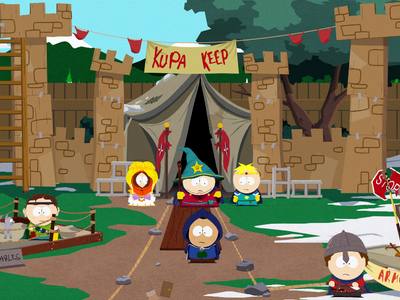Despain, ReynardFrost, Kilim and CaptainJet all return to discuss the concept of Show Don’t Tell, and how it applies to game design. Continue reading
AuthorDespain
So yesterday I beat South Park: The Stick of Truth. I loved it. I’ve always been a fan of South Park—its blend of cultural satire and immature toilet humor usually works surprisingly well. And I enjoy how episodes often call back to previous episodes. There’s a continuity to the series, which isn’t something that people might expect from that kind of show. And that continuity goes a long way towards making the world, characters and story of Stick of Truth so enjoyable, despite the relatively short (compared to most full-length RPGs) playtime.
But I’m not here to write a review of the game. You can find those all over the place. In fbb fashion, I want to take a hard look at the gameplay.
And South Park: Stick of Truth has some amazing RPG gameplay that went well above my expectations.
Gameplay-wise, Stick of Truth feels a lot like Paper Mario. And that’s a good thing—Paper Mario‘s not only one of my personal favorite games, but it’s a great example of an RPG battle system that promotes a lot of interactivity and gameplay that goes beyond scrolling through menus. Stick of Truth brings those same elements to its battle system while also innovating in a lot of ways that make the player feel good about what he’s doing. Even more—Stick of Truth goes beyond most RPGs in the ways it lets the player interact with the environment outside of battles. Continue reading
In this episode, Despain and Kilim are joined by CaptainJet to talk about the role of the hero characters in battle. Classes, stats, buffs/debuffs, skills—and the value of a turn. A lot of material is covered this time, so check it out.
Yo. I haven’t written about Your Fantasy Setting in a while. Last time I did one of these, we talked about economy, and fleshing out your game’s world by thinking about the role of trade and currency.
Today, let’s look at another aspect of your fantasy setting: the law. Sure, on some level, you’ve likely put some thought into the laws of your game world. After all, at one point the hero finds himself in the castle’s dungeon—or something like that. And for most of the game your hero will be stealing from random people’s homes… that’s legal, right? Continue reading
Today is the final part of a three-part article series about implementing and managing resources in your game. If you haven’t been following along, check out the first two articles in the series. Part one discussed the nature of resources in games, and went into some detail about different types. Part two dove deep into the implementation of resource systems.
Today’s subject is maybe the most important one in the series: making it fun for the player. Continue reading
It’s been a while since my last pixel art tutorial (over a year! sorry guys!), in which I introduced the basic ideas of animation. It’s time we dive into animation itself, and we’re going to start off by looking at one of the most important animations in game development: the walk cycle.
We’re going to be looking at the side view walk cycle (the front and back cycles will be explore in the next tutorial). Why? Multiple reasons. For one—it’s the most complicated, from a pixel art perspective. It typically takes more time to create the side view walk than the front or back views (the front and back walk cycles are easier to “cheat”).
But there’s a reason: the side view walk cycle best shows the motion of the limbs. Continue reading






